Last Updated on January 26, 2024 by Greg Gillson
Would you like to attract a larger variety of birds to your feeders?
Consider feeding birds suet.
This article answers questions about feeding birds suet.
- What is suet?
- Why feed birds suet?
- Who eats suet at the feeder?
- How do you feed birds suet?
- When do you feed suet to birds?
- Where do you hang a suet feeder?
I also answer other questions you may have.
 |
| Downy Woodpecker on suet cage feeder. Greg Gillson. |
What is suet for birds?
Traditionally, suet is the raw hard fat around kidneys of cows and sheep. When it comes to feeding birds, however, it has a wider meaning.
Suet for feeding birds is any kind of rendered (melted) animal fat or vegetable fat that is solid at room temperature. This is often mixed with rolled oats, corn meal, and flour as a base. Then various “flavors” are added, including peanut butter, berries or dried fruit, nuts, bird seed, or mealworms.
In fact, peanut butter can be used as the base, as a replacement for some of the fat.
I include a recipe below if you want to do it yourself.
Why feed suet to birds?
There are two reasons to feed birds suet. Suet is good for birds. Suet attracts a wider variety of birds to your bird feeder than just bird seed alone.
Suet is a high-energy food perfect for the high metabolic rate of birds. Suet provides birds fat and calories during migration and winter.
Suet is especially valuable to birds during prolonged cold spells. They need to maintain their high body temperature during the long cold nights. Suet helps them to do so.
What kind of birds eat suet?
A surprising variety of birds will eat suet. These include insect eaters, omnivores, and even some seed eating birds.
Chickadees, nuthatches, titmice, woodpeckers and jays are all highly attracted to suet. Wrens, warblers, kinglets, thrashers, starlings, blackbirds, creepers, cardinals, goldfinches, robins, bluebirds and mockingbirds are some of the other birds that will visit your feeders for suet.
Why would these birds eat suet (beef fat)? Isn’t that unnatural? Actually, no. This is animal protein the same as if they found a nice big juicy grub to eat. Yum!
Woodpeckers eat suet. Woodpeckers reported as eating suet include Downy Woodpecker, Hairy Woodpecker, Northern Flicker, Red-bellied Woodpecker, Gila Woodpecker, Red-headed Woodpecker.
Chickadees eat suet. All chickadees eat suet including Black-capped Chickadee, Carolina Chickadee, Chestnut-backed Chickadee, Mountain Chickadee.
Wrens eat suet. All wrens will eat suet. Those reported doing so include Bewick’s Wren, Carolina Wren.
Nuthatches eat suet. All nuthatches eat suet. These include Red-breasted Nuthatch, White-breasted Nuthatch, Pygmy Nuthatch.
Titmice eat suet. All titmice will eat suet. Those recorded doing so include Tufted Titmouse.
Kinglets eat suet. Ruby-crowned Kinglets eat suet.
Bushtits eat suet. Here they are!
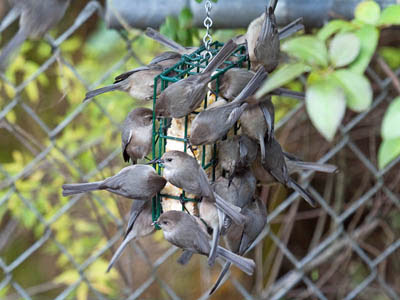 |
| Over 20 Bushtits on a suet feeder! Greg Gillson. |
Jays, magpies, and crows eat suet. That’s not unusual, as they also eat carrion. Those corvids recorded eating suet include Steller’s Jay, Blue Jay, California Scrub-Jay, Black-billed Magpie, American Crow. These birds can eat a lot of suet in a short time. See farther below for tips on reducing their presence at your suet feeder.
Some warblers eat suet. Especially do warblers that stay late in the fall or through the winter eat suet. These include Yellow-rumped Warbler, Pine Warbler.
European Starlings, grackles, cowbirds, and blackbirds eat suet. These flocking birds can cansume a lot of suet in a short time. See farther below for tips on reducing their presence at suet feeders.
Brown Creepers eat suet.
Northern Cardinals eat suet.
Thrashers eat suet. Brown Thrashers and Curve-billed Thrashers eat suet.
Goldfinches eat suet. American Goldfinches eat suet.
Robins and thrushes eat suet. American Robins, Varied Thrushes, Hermit Thrushes eat suet.
Bluebirds eat suet. Eastern and Western Bluebirds eat suet.
Northern Mockingbirds eat suet.
What other birds eat suet? Let everyone know in the comments below just who comes to your suet feeder!
How do you feed birds suet?
There are several ways to feed suet to birds.
Usually, you need suet AND a special suet feeder. Throughout this article I have included some links and recommendations for you of suet and suet feeders to buy.
Blocks of suet are often placed in a metal suet cage. [See the photo of Downy Woodpecker above.] The cage keeps larger birds, such as crows, ravens, magpies from stealing all the suet. Cages also prevent dogs from carrying off the whole block.
There are suet balls that are placed on a tray feeder or in special-built suet ball feeders.
Many bird feeders have suet feeder cages attached.
Certain suet (“bark butter”) can be spread on the bark of trees.
I wrote an earlier article you may enjoy: Where to hang a suet feeder to attract the most birds.
How do you keep unwanted birds from eating all the suet?
Upside-down suet feeders allow woodpeckers and small birds to feed easily on suet. However, it limits larger birds from eating all the suet. Upside-down suet feeders do a good job of thwarting Starlings, blackbirds, and jays from taking all the suet.
 |
| Black-capped Chickadee on upside-down suet feeder. Greg Gillson. |
I like the Nature’s Way upside-down suet feeder pictured above. It worked very well for me.
How to keep large birds from suet feeders?
How to keep starlings, grackles and blackbirds away from suet feeders?
How do you keep jays and crows away from suet feeders?
The upside-down suet feeder is a good choice for keeping larger birds such as jays and starlings from eating all the suet at your feeder.
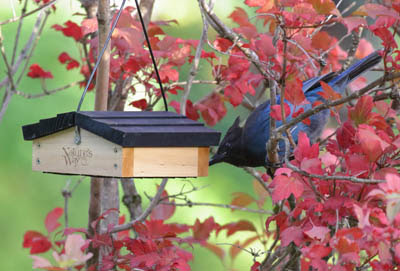 |
| Thwarted! Steller’s Jay at upside-down suet feeder. Greg Gillson. |
A squirrel baffle hung just over the suet will keep larger birds from suet.
There are some suet feeders that are surrounded by a cage that keeps out larger birds. But these tend to keep out several larger desirable birds too. But it’s perfect for feeding suet to chickadees, titmice, and nuthatches.
When should you feed birds suet?
Suet is often fed as a winter bird food. It does get soft and messy in summer heat, though the melting temperature is generally at or above 113 degrees F.
No-melt suet should be fine up to 130 degrees F. Many people feed suet to birds year-round.
The problem with suet in summer is two-fold.
Firstly, suet gets soft in summer heat (95 degrees F for rendered fat) and can mess up the bird’s feathers. It’s also quite messy to put it into the feeder when the suet is soft.
Does suet go bad?
Secondly, suet can go rancid. You should only put out an amount of suet that birds can eat in a week. Old suet, or suet showing mold or mildew should be removed and the suet cage cleaned. The fat itself doesn’t go rancid, rather it’s the other ingredients such as oat or corn meal or fruit. If it smells sour, it’s bad.
Wrapping Up
Suet is a type of food commonly used to attract and feed birds, especially during colder months when natural food sources may be scarce. It’s essentially rendered beef fat, processed by removing the meat and leaving behind a solid block of fat. This fat is then often mixed with other ingredients like seeds, nuts, dried fruit, and mealworms to create suet cakes or suet balls, making them more nutritious and appealing to a wider variety of birds.
Here’s a breakdown of what makes suet a valuable bird food:
High Energy Content:
- Suet is primarily composed of fat, offering a concentrated source of energy crucial for birds to survive harsh winters and maintain their body temperature.
- This is especially important for smaller birds with faster metabolisms who need to replenish their energy quickly.
Nutritious Ingredients:
- While the base ingredient is fat, adding seeds, nuts, and dried fruit enriches the suet with vitamins, minerals, and protein, further benefitting bird health.
- These additional ingredients also attract a wider variety of bird species with different dietary preferences.
Easy to Digest:
- Compared to some seeds that may require effort to crack open, suet is readily digestible for birds, allowing them to quickly access the energy they need.
- This is particularly helpful for birds with weaker beaks or chicks developing their feeding skills.
Long-Lasting:
- Suet’s solid form makes it less prone to spoilage compared to other bird food options like seeds.
- It can withstand colder temperatures and remain available to birds for longer periods.
Frequently Asked Questions
How do you store suet?
Store suet in a shaded, cool area until needed. You may also freeze it.
Do the flavors of suet matter?
Not that I’ve seen. But maybe I haven’t experimented enough. I noted no difference in the appeal of the berry or the peanut of the suet I offered (but I bought it because it was the cheapest). Try different flavors and let me know in the comments below!
Can I make my own suet?
Yes, you can!
Google “homemade suet for birds.”
Here’s a peanut butter suet recipe from Birds and Bloom (source)
- 1 cup peanut butter
- 1 cup lard
- 2 cups of oatmeal (not instant)
- 2 cups mixed bird seed
- 1 cup of corn meal
- 1 cup of flour
Melt the lard and peanut butter together over low heat. Mix other ingredients into large bowl. Pour the melted ingredients into the dry ingredients in a large bowl and stir together. form into chunks and cool in refrigerator for 2 hours.
From this basic recipe you can go crazy with other additions.
It’s less messy just to buy it, but probably not as fun!
Related Articles:






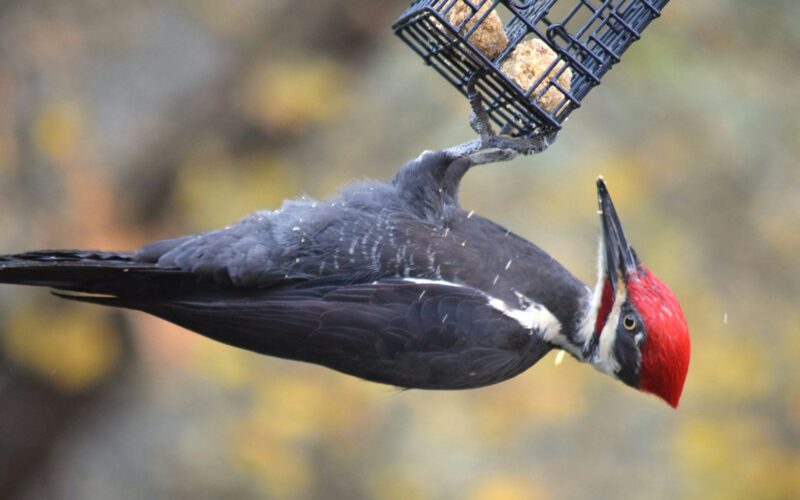
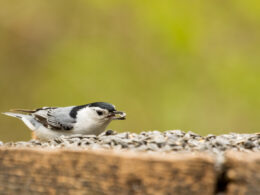
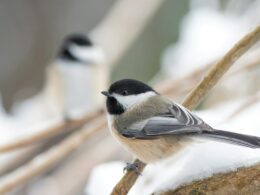
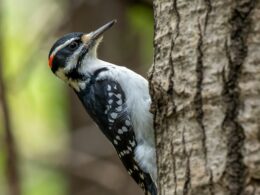
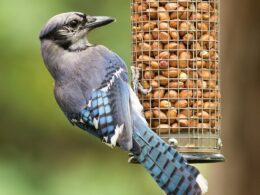
Excellent article and I will purchase Suet for the bvariety of birds it attracts.
You should have mentioned using
pepper suet that stops squirrels and racoons and chipmunks etc. From eating the suet.
Great article. I make my own suet and look forward to trying your recipe as well! 🙂
This year I used both purchased suet blocks with added seeds and grains and "pure" suet from my butcher. Most of the bird varieties seem to prefer the straight stuff!
Thank you for mentioning that!
iIve noticed the same thing, but haven't experimented enough to say so definitively.
My squirrels love spicy food. 🙄
I've heard that some squirrels develop a taste for spicy foods; while it does deter others.